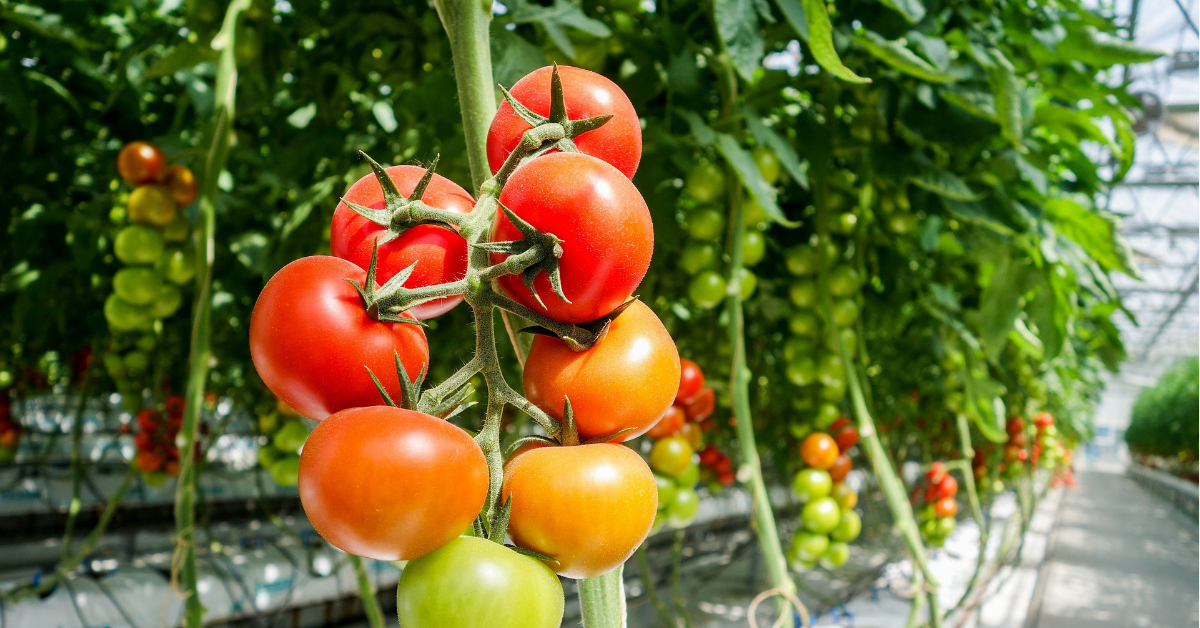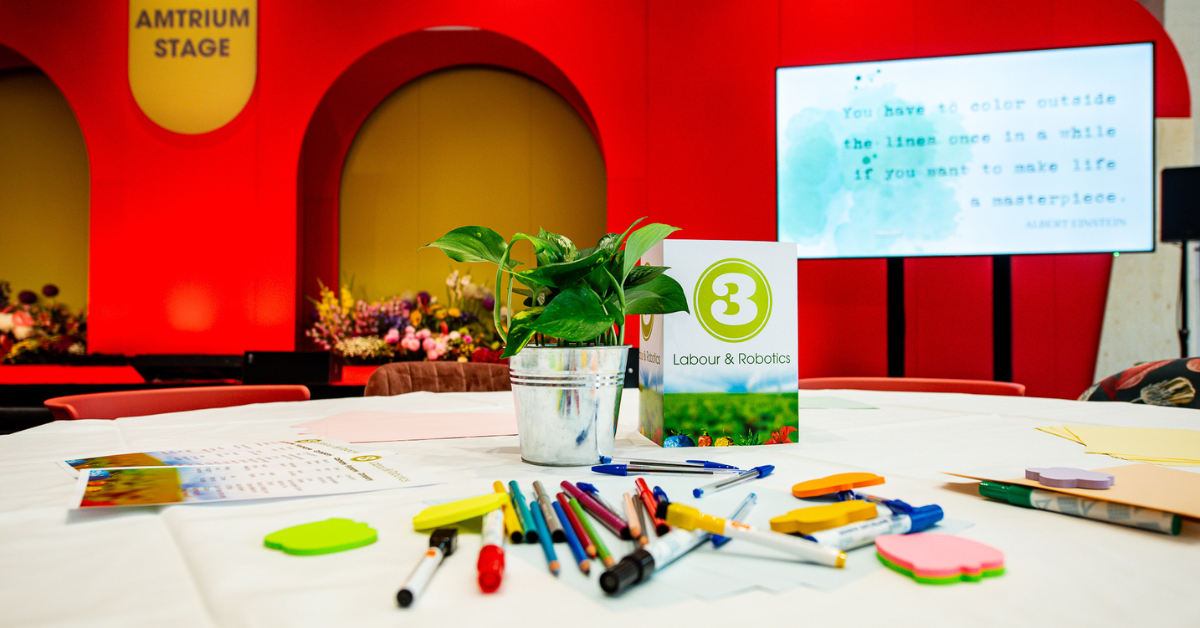Pests and diseases resilient crops
Author: Rachel Anderson
Monday, 21 October 2024
The many colourful potted flowering plants and samples of salad vegetables on display at this year’s GreenTech Amsterdam trade show were a poignant reminder of the splendid crops produced by the horticulture sector.
Visitors were shown how breeders’ new floral selections continue to be beautiful and unusual – whilst flavoursome fresh produce continues to brighten up consumers’ plates.
But with the effects of climate change and a burgeoning worldwide population to consider, today’s horticulture crops are being bred to be more resilient and adaptable than ever before. This way, they can better cope with these global challenges.
Nunhems/BASF Vegetable Seed’s Consumer and Customer Manager (Netherlands, Germany, Belgium) Hans Driessen emphasises, for example, that vegetable seed breeders have worked – and continue to work – hard to develop tomato varieties that are resistant to the damaging tomato brown rugose fruit virus (ToBRFV) since the virus’ discovery in 2014.
“The main challenge has been to keep the products’ consumer-related traits (such as flavour, presentation) at the same, or an even better, level. Fortunately, popular varieties such as Vitalion and Ronvine have successfully achieved this. And now, we’re developing completely new material that has even stronger resistance to the virus by crossing two ‘parents’ with ToBRFV resistance.”
Nunhems’ original portfolio of some 25 resistant varieties was developed using a technique named backcross breeding, which involves repeatedly crossing offspring with an existing parent to introduce a specific trait. Nunhems’ new ToBRFV-resistant varieties, to be released in 2025, have been developed using a technique named “forward breeding”, which crosses two parent plants with desirable traits to produce varieties that combine these traits.
Driessen also notes that, with longer/extended cucumber growing seasons in mind, breeders are now focussing on finding genetic material that can grow in lower temperatures so that they may produce high-yielding, high-quality crops during wintertime.
Shuang Fan, Account Manager Horticultural Projects at Rijk Zwaan, adds that cucumber breeders have been introducing greater resistance to devastating diseases such as cucumber green mottle mosaic virus (CGMMV). Such cucumbers include, for example, Rijk Zwaan’s Bon Defense line of CGMMV-resistant cucumber varieties – of which the new organic cucumber variety Bonsagan RZ is a part.
Breeding for resilience is also a key focus for the floriculture sector, with breeders such as HilverdaFlorist – whose show-stealing varieties on display at GreenTech Amsterdam included its Garden Gerbera Garvinea® Sweet Chili – maintains partnerships with Wageningen University and other external laboratories to research genetic resistances.
Driessen highlights that, for lettuce/leafy greens, Nunhems’ varietal development is focussing on colourful crops that are optimised to suit hydroponic cultivation (including indoor vertical hydroponic systems) as well as High Density Mechanical Harvesting (HDMH). This means that each stage of production – namely, the sowing, growing, and harvesting – can be automated. The ultimate aim of this research and development is, notes Driessen, “to create a 12-month safe supply of food.” Hydroponic lettuce varieties on display at GreenTech that have been bred to suit this type of cultivation included, for instance, the butterhead lettuce Geoffry and the red-leaved Multired 80.
Meanwhile, the floriculture breeder Anthura, whose new potted varieties on display at GreenTech included the fiery-coloured anthurium Banderola® Lava and the orchid Manta® Split – utilised GreenTech Amsterdam 2024 to highlight the fact that ornamental plants are also well-suited to vertical farming cultivation.
The company stated that, whilst vertical farming is commonly used to grow lettuce and baby leaves, ornamental plants are particularly suited to this type of horticulture production in areas of the world where growing conditions are challenging. In fact, the company's extensive testing has demonstrated the suitability of their varieties for vertical farms.
Emphasising the environmental benefits of local-for-local production, Anthura’s commercial director Marco van Herk says: “Anthura is now focusing on breeding varieties that thrive optimally in vertical farms, regardless of location. We offer sterile tissue culture plants to ensure disease-free cultivation. Our research shows that these varieties can also be successfully cultivated in less than ideal locations.”
Evidently, whether the focus is on year-round cultivation, local production, or increased resilience to pests and pathogens, breeders are doing their utmost to help the global horticulture sector sustainably feed, and bring joy to, consumers. Moreover, they’re embracing the many commercial opportunities offered to them by the evolving horticulture sector.
Visitors were shown how breeders’ new floral selections continue to be beautiful and unusual – whilst flavoursome fresh produce continues to brighten up consumers’ plates.
But with the effects of climate change and a burgeoning worldwide population to consider, today’s horticulture crops are being bred to be more resilient and adaptable than ever before. This way, they can better cope with these global challenges.
Pests and disease resistance
Pests and diseases can cause significant economic damage to controlled environment horticulture crops and are one of the major challenges for the sector. New vegetable varieties are therefore being bred to have built-in resistance to pests and pathogens – reducing both the risk of crop losses and growers’ dependency on crop protection chemicals.Nunhems/BASF Vegetable Seed’s Consumer and Customer Manager (Netherlands, Germany, Belgium) Hans Driessen emphasises, for example, that vegetable seed breeders have worked – and continue to work – hard to develop tomato varieties that are resistant to the damaging tomato brown rugose fruit virus (ToBRFV) since the virus’ discovery in 2014.
“The main challenge has been to keep the products’ consumer-related traits (such as flavour, presentation) at the same, or an even better, level. Fortunately, popular varieties such as Vitalion and Ronvine have successfully achieved this. And now, we’re developing completely new material that has even stronger resistance to the virus by crossing two ‘parents’ with ToBRFV resistance.”
Nunhems’ original portfolio of some 25 resistant varieties was developed using a technique named backcross breeding, which involves repeatedly crossing offspring with an existing parent to introduce a specific trait. Nunhems’ new ToBRFV-resistant varieties, to be released in 2025, have been developed using a technique named “forward breeding”, which crosses two parent plants with desirable traits to produce varieties that combine these traits.
Driessen also notes that, with longer/extended cucumber growing seasons in mind, breeders are now focussing on finding genetic material that can grow in lower temperatures so that they may produce high-yielding, high-quality crops during wintertime.
Shuang Fan, Account Manager Horticultural Projects at Rijk Zwaan, adds that cucumber breeders have been introducing greater resistance to devastating diseases such as cucumber green mottle mosaic virus (CGMMV). Such cucumbers include, for example, Rijk Zwaan’s Bon Defense line of CGMMV-resistant cucumber varieties – of which the new organic cucumber variety Bonsagan RZ is a part.
Breeding for resilience is also a key focus for the floriculture sector, with breeders such as HilverdaFlorist – whose show-stealing varieties on display at GreenTech Amsterdam included its Garden Gerbera Garvinea® Sweet Chili – maintains partnerships with Wageningen University and other external laboratories to research genetic resistances.
Mechanisation, Hydroponics and Vertical Farming
Many salad varieties, such as Rijk Zwaan’s award-winning snack-size Tatayoyo pepper, are easy to locate and pick and therefore suited to automatization and robotization –technologies that the sector will increasingly deploy in future.Driessen highlights that, for lettuce/leafy greens, Nunhems’ varietal development is focussing on colourful crops that are optimised to suit hydroponic cultivation (including indoor vertical hydroponic systems) as well as High Density Mechanical Harvesting (HDMH). This means that each stage of production – namely, the sowing, growing, and harvesting – can be automated. The ultimate aim of this research and development is, notes Driessen, “to create a 12-month safe supply of food.” Hydroponic lettuce varieties on display at GreenTech that have been bred to suit this type of cultivation included, for instance, the butterhead lettuce Geoffry and the red-leaved Multired 80.
Meanwhile, the floriculture breeder Anthura, whose new potted varieties on display at GreenTech included the fiery-coloured anthurium Banderola® Lava and the orchid Manta® Split – utilised GreenTech Amsterdam 2024 to highlight the fact that ornamental plants are also well-suited to vertical farming cultivation.
The company stated that, whilst vertical farming is commonly used to grow lettuce and baby leaves, ornamental plants are particularly suited to this type of horticulture production in areas of the world where growing conditions are challenging. In fact, the company's extensive testing has demonstrated the suitability of their varieties for vertical farms.
Emphasising the environmental benefits of local-for-local production, Anthura’s commercial director Marco van Herk says: “Anthura is now focusing on breeding varieties that thrive optimally in vertical farms, regardless of location. We offer sterile tissue culture plants to ensure disease-free cultivation. Our research shows that these varieties can also be successfully cultivated in less than ideal locations.”
Evidently, whether the focus is on year-round cultivation, local production, or increased resilience to pests and pathogens, breeders are doing their utmost to help the global horticulture sector sustainably feed, and bring joy to, consumers. Moreover, they’re embracing the many commercial opportunities offered to them by the evolving horticulture sector.
Have exclusive horticulture technology news delivered to your inbox
The GreenTech monthly newsletter brings you the latest exclusive horticulture technology news and updates about our global horticulture technology trade shows and events.
Join over 32,000 of your peers and receive:
☑ Exclusive commentary from industry leaders
☑ The latest news from the GreenTech team
☑ Stay up to date with all the latest news about our events





